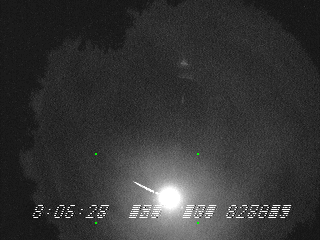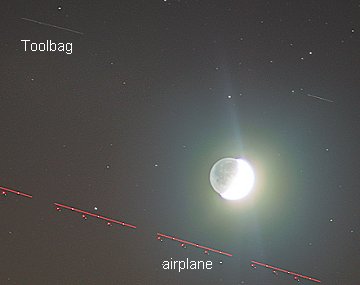From the wonderful Space Weather:
AURORA WATCH: High-latitude sky watchers should be alert for auroras tonight. A solar wind stream is buffeting Earth’s magnetic field, sparking Northern Lights as far south as Michigan: gallery.
COLORADO SUPERBOLIDE: Last night, Dec. 6th at 1:06 a.m. MST, a meteor of stunning brightness lit up the skies of Colorado. Astronomer Chris Peterson photographed the event using a dedicated all-sky meteor camera in the town of Guffey, near Colorado Springs:
"In seven years of operation, this is the brightest fireball I’ve ever recorded," says Peterson. "I estimate the terminal explosion at magnitude – 18, more than 100 times brighter than a full Moon."
Fireballs this bright belong to a rare category of meteors called superbolides. They are caused by small asteroids measuring a few to 10 meters in diameter and massing hundreds of metric tons. Superbolides trigger seismic detectors on the ground, produce waves of infrasound that can travel thousands of miles, and they are tracked by military satellites scanning Earth for nuclear explosions. Recent examples include the El Paso fireball of 1997 and the Slovenian Superbolide of 2007.
Last night’s fireball is on the low end of the superbolide scale. Nevertheless, it was still a beauty and likely peppered the ground with meteorites when it exploded. Sighting reports are welcomed; they could help guide the tracking and recovery of debris.
LISTEN! 250 miles south of the fireball, radio astronomer Thomas Ashcraft of New Mexico photographed the flash and recorded radio echoes from the superbolide’s ion trail. Click here to listen.
TUMBLING TOOLBAG: The space station’s famous sidekick, the ISS Toolbag, is circling Earth and producing flashes of light bright enough to record using off-the-shelf digital cameras. Peter Rosén sends this report from downtown Stockholm, Sweden:
"I photographed the toolbag when it passed above the moon on Dec. 3rd. It was invisible to the naked eye, but my camera (a Canon 40D) detected it in a series of 4 second exposures. The toolbag must be rotating as the light seems to flash and disappear." (continued below)
Photo details: Canon 40D, 85mm lens, f/1.2, ISO 100, 26 x 4 secHe combined 26 images to create this composite. "The other paths are from airplanes; the short interruptions in their lights are caused by the lag between shots." Longer "black-outs" in the path of the toolbag appear to be genuine, a result of tumbling and flashing.
Readers, the toolbag and the ISS are making a series of evening passes over Europe and North America this weekend. Check the Simple Satellite Tracker for flyby times.




































Spaceweather is my favorite website.
It’s always got something great.
Lucky Colorado night owls last night!
Auroras are supercool. I’ve only seen them a couple few times in my life, since I live in Ohio, but they’re always amazing.
ISS Toolbag… Snerk!
Thanks for those references! I will have to check out the spaceweather site!
the pictures do not show
Dang. I live in Colorado Springs, but was asleep.
I have always wanted to see the aurora. Sigh. down here in Virginia it doesn’t appear. wah. To see the electricity and color play in the sky…
Wow!
Goodness, gracious, Great……wait for it…..sorry everyone, I had to do it……Balls of Fire! :)
Semper Fi!